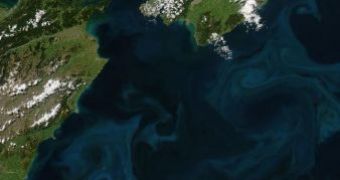If ocean waters turned from greenish to blue, that would seriously affect the path and the number of hurricanes, according to a research carried out by a team from the National Oceanic and Atmospheric Administration's Geophysical Fluid Dynamics Laboratory in Princeton, New Jersey.
The team's leader, Anand Gnanadesikan said that “we think of the oceans as blue, but the oceans aren't really blue, they're actually a sort of greenish color [and] the fact that [the oceans] are not blue has a [direct] impact on the distribution of tropical cyclones.”
A simulation of a change in the chlorophyll level in a region of the North Pacific, found that the formation of hurricanes in that area decreased by 70 percent. Which would be a big drop for a region that has more than half the world's accounted hurricane-force winds.
The explanation is quite simple: hurricanes or typhoons, as they are called in that area, are influenced by the existence of chlorophyll in the water.
Chlorophyll is a green pigment that helps phytoplankton convert sunlight into food for the entire marine ecosystem, and it is also what gives the color of the oceans.
This study, that will be published in the next issue of Geophysical Research Letters, a journal of the American Geophysical Union, explains how a drop in the chlorophyll concentration, with its corresponding color change in the waters, could reduce the formation of hurricanes in that specific area.
Gnanadesikan compared the actual level of chlorophyll in the North Pacific with a simulated scenario of zero chlorophyll concentration in parts of the North Pacific Subtropical Gyre, and found out that the lack of chlorophyll in the subtropical gyre changed air circulation and heat distribution within and beyond the whirl.
The direct consequence was a 70 percent decrease in storms up North and a 20 percent growth in hurricane formation along the equator, meaning that hurricanes would be hitting Vietnam and the Philippines instead of South China and Japan.
The lack of chlorophyll in the ocean waters allows sunlight to penetrate deeper into the ocean and prevent the overheating of the surface water.
Hurricane formation is affected by the fewer energy provided by cold water, by the drier air caused by air circulation pattern change and also by stronger winds aloft that keep thunderstorms from developing into hurricanes.
Gnanadesikan said that the total lack of chlorophyll in areas of the ocean would change things dramatically, nevertheless its potential impact should be considered.

 14 DAY TRIAL //
14 DAY TRIAL //